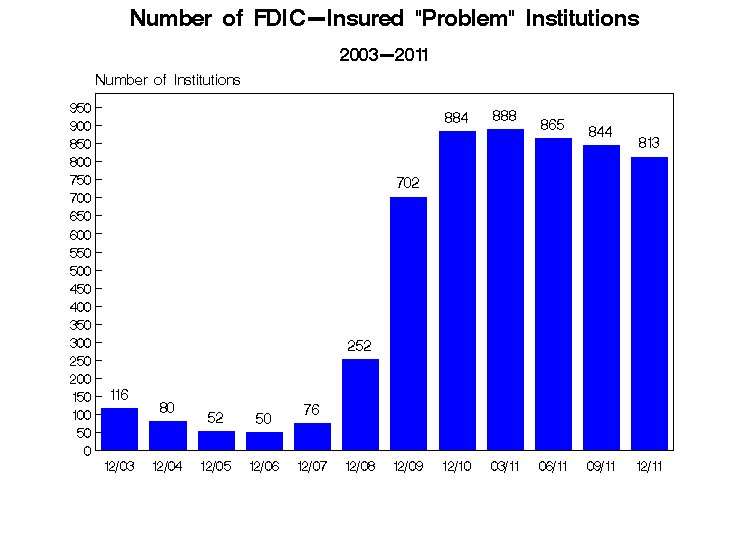The FDIC released the list of enforcement actions taken in February 2012 against 53 banks. In the previous month of January, the FDIC had issued 42 enforcement actions.
The orders issued by the FDIC included 10 civil money penalties, 1 prompt corrective action, 13 consent orders, 1 order terminating deposit insurance and 19 orders terminating consent orders and desist orders. The FDIC currently insures deposits at 7,359 banks and savings associations and is charged with promoting safety and soundness by monitoring, identifying and addressing risks that financial institutions are exposed to.
Although the number of banks on the Problem Bank List has declined for three quarters in a row, the number of problem banks remains high. At March 31, 2011, the FDIC classified 888 banks as “problem banks.” As of the latest reported numbers for December 31, 2011, the number of problem banks had declined by only 75 banks to a total of 813.
 Considering the fact that a total of 82 banks have failed since March 31, 2011, effectively removing them from the Problem Bank List, there has been a net addition to the Problem Bank List of 7 banks over the past year. In addition, the number of problem banks is the highest since September 30, 1992 when the Problem Bank List contained the names of 1,066 banks. In the third quarter of 2006, there were only 47 problem banks.
Considering the fact that a total of 82 banks have failed since March 31, 2011, effectively removing them from the Problem Bank List, there has been a net addition to the Problem Bank List of 7 banks over the past year. In addition, the number of problem banks is the highest since September 30, 1992 when the Problem Bank List contained the names of 1,066 banks. In the third quarter of 2006, there were only 47 problem banks.
Although regulators tell us the financial crisis has been contained, there is still a discomforting number of troubled banks. A total of 11% of all FDIC insured institutions are currently classified as problem banks. Another troubling aspect for depositors is the fact that the FDIC Deposit Insurance Fund (DIF) at December 31, 2011 had a balance of only $9.2 billion which “protects” a massive $6.98 trillion of customer deposits. Although the FDIC has taken measures to bolster the DIF fund, the reserve ratio remains at a historically low level of only 0.13%. The FDIC currently has only around $1,318 to protect every $1 million dollars in deposits.
The FDIC issues a consent order to a bank that is determined to be engaged in unsafe or unsound banking practices. A bank that signs a regulatory consent order agrees to commit itself to resolving the issues cited by the FDIC. If a bank materially complies with a consent order, the order may be terminated.
Far more serious than a consent order is a prompt corrective action notice (PCA). A bank issued a PCA is directed to take immediate actions to return the finances of the bank to “minimum capital standards”. A bank issued a PCA is usually classified as undercapitalized, significantly undercapitalized or critically undercapitalized and considered to be operating in an “unsafe and unsound” manner.
To see the full listing of FDIC enforcement actions taken against problem banks for February 2012, click on this interactive FDIC link –FDIC Enforcement Decisions and Orders.
Although some progress has been made in the clearing of problem asset properties, it is clear that an increased number of responsible real estate investors still need to come forward to purchase, renovate, and sell or rent out these assets with troubled loans. It will be good for everyone.